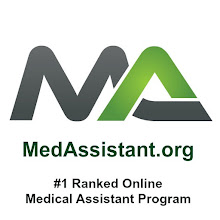What do Medical Assistants do?
 Medical Assistants: Career, Salary and Education Information
Medical Assistants: Career, Salary and Education InformationCareer Profile: What do Medical Assistants do? Trusted to keep medical documents safe, medical assistants are an indispensable force in physicians' offices. In smaller offices, medical assistants do it all, taking on both administrative and clinical responsibilities. Medical assistants can specialize in ophthalmic, optometric, or podiatric capabilities, to name a few, or they can stick to general practice in general medical and surgical hospitals.
Strong organizational skills are essential for the job. Medical assistants must often work in a customer service capacity, handling correspondence and scheduling appointments. Because they often serve as a link between patients and medical personnel, assistants must have strong communication skills.
A Day in the Life of a Medical Assistant
The daily tasks of a medical assistant depend highly on their job description and location. Administrative tasks might include filing patient records, arranging for hospital admissions or laboratory services, or filling out insurance forms. Clinical duties could include recording vital signs, explaining treatment procedures, changing dressings, and preparing patients for x-rays and other procedures. Regardless of their individual duties, most medical assistants work 40 hour work weeks in well-lighted, clean environments. Depending on the office hours and clinical scope, some may work part-time, evenings, or weekends. Medical assistants work in well-lighted, clean environments. They constantly interact with other people and may have to handle several responsibilities at once. Most full-time medical assistants work a regular 40-hour week. However, many medical assistants work part time, evenings, or weekends.
The job prospects for medical assistants in 2008
Job seekers who want to work as a medical assistant should find excellent job prospects! Medical assistants are projected to account for a very large number of new jobs, and many other opportunities will come from the need to replace workers leaving the occupation. Those with formal training or experience—particularly those with certification—should have the best job opportunities. The earnings of medical assistants and medical assistant pay vary, depending on their experience, skill level, and location. Median annual earnings of wage-and-salary medical assistants were $26,290 in May 2006. The middle 50 percent earned between $21,970 and $31,210. The lowest 10 percent earned less than $18,860, and the highest 10 percent earned more than $36,840.
Top online medical assistant schools:
St. Augustine School of Medical Assistants
Website: www.MedAssistant.org
Overall rating: 5/5 stars *****
More about medical assistant jobs:
Medical assistants perform work similar to the tasks completed by other workers in medical support occupations. As the health care industry expands because of technological advances in medicine and the growth and aging of the population, there will be an increased need for all health care workers. Increasing use of medical assistants in the rapidly growing health care industry will further stimulate job growth.Helping to drive job growth is the increasing number of group practices, clinics, and other health care facilities that need a high proportion of support personnel, particularly medical assistants who can handle both administrative and clinical duties. In addition, medical assistants work primarily in outpatient settings, a rapidly growing sector of the health care industry.
Labels: what are medical assistants?


<< Home